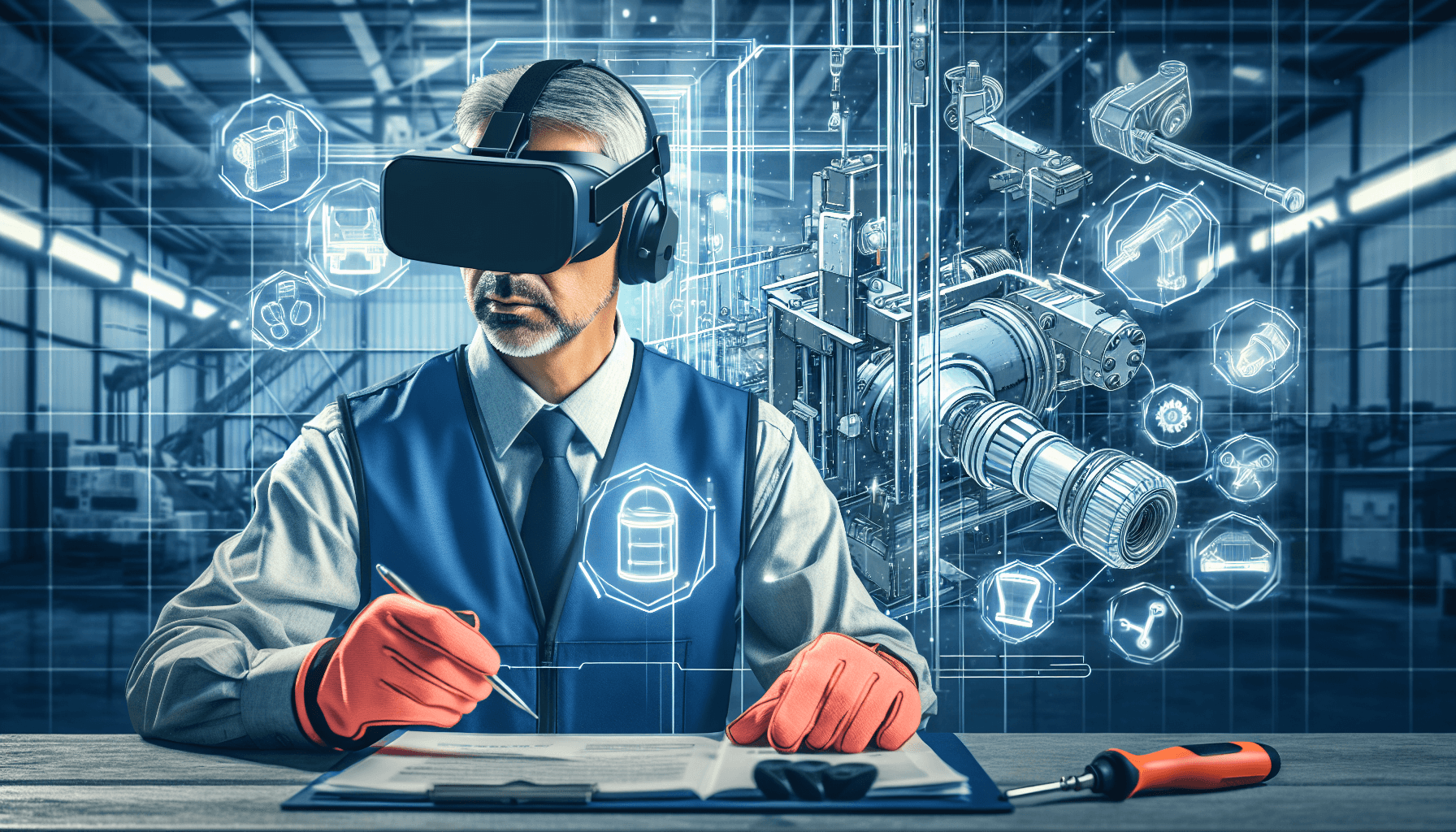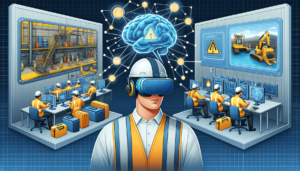In the rapidly evolving landscape of industrial sectors, VR industrial training stands as a transformative technology, reshaping how workforce skillsets are developed and enhanced. This innovative approach to training leverages the power of virtual reality to simulate real-world environments and scenarios, offering a level of immersion and interactivity previously unimaginable. Not only does this method significantly reduce the risks associated with hazardous work, but it also brings unprecedented scalability and customization to the training process, making it a critical tool in today’s industry for everything from maintenance training to new hire onboarding.
The upcoming parts of this article will explore the role of VR in industrial training, focusing on its numerous advantages including improvements in safety training, cost reductions, risk minimization, and the overall effect on training through virtual reality. We will explore how VR for manufacturing and other industries offers an immersive training experience that not only improves the efficiency and effectiveness of the workforce but also opens up new avenues for innovation in training methods. The discussion will then shift to the future outlook and the latest innovations in VR industrial training, providing a comprehensive overview of how this technology is set to continue transforming industrial training landscapes.
Understanding the Role of VR in Industrial Training
Definition and Basics of VR
Virtual Reality (VR) creates environments, experiences, and interactions that appear real, engaging multiple senses including sight, sound, touch, and movement. Users wearing VR headsets are transported into a three-dimensional, interactive world.
Historical Evolution and Current Landscape
The journey of VR began with Ivan Sutherland’s invention of the first head-mounted display in 1968, known as “The Sword of Damocles.” This laid the groundwork for today’s VR devices. Over the decades, technological advancements have propelled VR from gaming systems developed by companies like Sega and Nintendo to high-quality VR headsets by Oculus and HTC Vive in the 2010s.
Overview of Industries Leveraging VR for Training
Various industries including healthcare, education, architecture, and engineering have adopted VR. It’s used by surgeons for complex procedures, by students to explore ancient civilizations, and by architects for virtual walkthroughs of buildings before construction. In the industrial sector, VR enhances training for hazardous work, providing safe, realistic simulations of environments like aviation, healthcare, and manufacturing.
Benefits of Using VR in Industrial Training
Enhanced Safety and Risk Management
VR training eliminates the risks associated with training in hazardous environments, allowing trainees to learn from mistakes without endangering themselves or others. By providing a controlled and safe space, trainees can practice and refine their skills without the inherent dangers of real-world scenarios. This safety aspect is particularly crucial in industries such as construction, firefighting, and medical fields, where on-the-job training can be perilous. Furthermore, VR training helps to prevent accidents and injuries that could occur during traditional training methods, thereby protecting both the trainees and the trainers.
By simulating dangerous situations, VR ensures safety while enabling effective emergency response training. Trainees can experience realistic scenarios, such as natural disasters, industrial accidents, or medical emergencies, without the associated risks. This immersive training method enhances their ability to respond promptly and efficiently in real-life situations. Additionally, VR can be used to repeatedly practice scenarios until the trainees achieve a high level of proficiency, ensuring they are well-prepared for actual emergencies. This method not only improves safety but also boosts confidence and competence among trainees, ultimately leading to better preparedness and risk management in their respective fields.
Improved Learning Retention and Skill Mastery
The immersive nature of VR training significantly enhances knowledge retention, with studies showing up to a 75% retention rate compared to traditional methods’ 10%. This immersive experience helps forge neural pathways, crucial for learning and memory.
The effectiveness of VR training in fostering skill mastery cannot be overstated. By allowing learners to practice in a risk-free environment, they can repeatedly perform tasks, which solidifies their understanding and improves their proficiency. This hands-on approach not only boosts confidence but ensures that skills are deeply ingrained, preparing individuals for real-world applications more effectively than conventional training methods.
Customizable and Scalable Training Solutions
VR training offers highly customizable and scalable solutions, allowing organizations to tailor training programs to specific needs and scale them according to workforce requirements. This flexibility is critical for adapting to various industrial demands and enhancing training accessibility.
Moreover, the dynamic nature of VR training enables it to keep pace with the evolving demands of modern learning environments. As industries evolve and new challenges emerge, VR training can be quickly updated or expanded to include new scenarios, technologies, and methodologies. This ensures that training programs remain relevant and effective, providing learners with the skills and knowledge they need to succeed in an ever-changing professional landscape.
Cost-Effectiveness and Operational Efficiency
VR training reduces the need for expensive physical resources, cutting down on costs significantly. Organizations can achieve better operational efficiency as VR training requires less time, reducing productivity loss and enabling quicker employee turnaround.
Future Outlook and Innovations in VR Industrial Training
Advancements in VR Technology
Advancements in computer and graphical processing capabilities have significantly reduced the cost of creating virtual environments, making VR more accessible across various industries like oil, gas, and power generation. Furthermore, the development of haptic technology, such as gloves and suits, enhances the sensory experience by allowing users to feel the weight and texture of virtual objects.
Increasing Affordability and Accessibility
The projected increase in spending on AR/VR products and services indicates a growing acceptance and implementation of VR technologies in industrial training, suggesting a trend towards more widespread and affordable VR training solutions.
Integration with AI and Machine Learning
AI integration in VR is enhancing user experiences by creating more realistic and responsive environments. AI-driven NPCs (Non-Playable Characters) and avatars add depth to VR training by responding intelligently to user actions, making the training experience more dynamic and effective. Additionally, AI technologies are employed to reduce 3D world-building times and improve the authenticity of virtual environments.
Predictions for VR Training Applications
With the increasing adoption of remote work, VR training is expected to become more prevalent, especially for soft skills like communication and leadership. The integration of VR with AI and AR is predicted to create more personalized and immersive learning experiences, thereby increasing the effectiveness of training programs. Furthermore, industries are likely to continue investing in VR to simulate risky situations safely, ensuring better preparedness for real-world challenges.
Conclusion
Throughout this article, we’ve explored the transformative power of VR in industrial training, underscoring its capacity to revamp workforce training through immersive, interactive simulations. From enhancing safety and reducing risks to cutting operational costs and improving learning retention, VR’s benefits are manifold, offering customizable, scalable training solutions that cater to a wide array of industrial needs. The integration of VR into industrial training not only marks a significant leap towards innovative learning methodologies but also exemplifies the merging of technology with traditional training to foster a more efficient, safe, and competent workforce.
Looking forward, the evolution of VR technology, combined with advancements in AI and machine learning, forecasts an even broader application of VR in industrial training realms. As VR becomes more accessible and integrated with other technologies, its potential to revolutionize training programs grows exponentially. This progression promises not only to refine the ways in which industrial training is conducted but also to expand its reach, ensuring that industries can prepare their workforces for the complexities of modern-day challenges with greater efficacy and precision. Engaging with and investing in VR training will invariably equip industries to navigate the future with confidence.
FAQs
How is virtual reality impacting the workforce?
Virtual reality (VR) is revolutionizing the workforce by enabling increased collaboration through virtual workspaces that simulate physical offices. This technology allows employees to interact and collaborate as if they were in the same room, even if they are located in different parts of the world. The result is a reduction in geographical barriers and enhanced global teamwork.
What are the six workplace benefits of immersive learning with AR and VR?
The six key benefits of using Augmented Reality (AR) and Virtual Reality (VR) for immersive learning in the workplace include: reducing risks, decreasing the time required for training, increasing contextualization of learning material, saving costs, evoking strong emotional responses, and enhancing memory retention.
How are companies utilizing VR to enhance soft skills?
Companies are leveraging VR to develop soft skills among employees, particularly in retail. Store managers use VR training to simulate conversations with team members on various challenging topics such as tardiness, inappropriate customer service practices, and shift scheduling. This immersive practice helps in enhancing communication and managerial skills.
What are the advantages of employing VR in training programs?
Using VR in training programs offers numerous benefits, including a quicker speed to proficiency, reduced onboarding time, enhanced customer service, improved workplace safety, reduced employee turnover, fewer costly incidents, and a more effective method for quickly instilling company culture.


